.
Dated: November 15, 2015
Italian Military Organizations
1943-45
Fascists
Army -
Royal
Army - Partisan
This page presents a general
overview
of the Italian military and politcal organization. If you think
the post-war Italian
political
history is confusing, the military history is even more. This
describes
the different organizations during Mussolini's reign and the Royal Army
after
he was made a puppet to the Germans from 1943 to 1945.
For
other
units, go to:
For more history of Italy during WW2:
|
Fascists
|
Rise
and Fall of Mussolini and the Fascists.
|
| Italy in WW2 |
History
of Italy's involvment in the War.
History of King Victor Emmanuel III.
|
Partisan Organization
|
A sketchy overview of the Partisans in
Italy.
|
| Executuion
of Mussolini |
The
Last few days of Mussolini.
WARNING: Contains photos not suitable for children.
|
Military
Organization of Fascists Army
Pre-September
1943
Fascist
Party Militia or Milizia Volontaria Sicurezza Niazionale (MVSN).
The
MVSN
(Volunteer
Militia for National Security) was the Fascist
Militia
formed soon after Mussolini's rise to power in 1923. The primary
function of the MVSN was political control and police duties. Its
military
function was the organization of Black Shirt battalions for service
within
each division of the Royal Army. The MVSN were
distinguished
by their uniform in several ways. The fascio emblem was
used
on the hat and the collar tabs. A black shirt uniform was worn,
except usually
not in combat.
Black Shirts
or Squadracce Nere - The Black Shirt battalions were
orignally the strong arm of the party
and were known as the squadristi.
They served in independent groups or as assault battalions attached to
the regular army divisions. There was some resistance to
incorporating
the Black Shirts into the regular army and Il Duce had to issue
an order requiring it in 1941. Two Black Shirt battalions were
organized
for each of the 133 MVSN legions. A battalion consisted of 20
officers
and 650 men.
Separate Black Shirt
divisions were organized for the
Ethiopian campaign. The six divisions were named after important dates
in Fascist's history: 23
Marzo, 28
Ottobre,
21 Aprile, 3 Gennaio, 1 Febbraio & Trevere.
As a result of the outbreak
of WW2 in 1939, four
divisions
were raised but all were captured in North Africa. The four were:
21 Aprile Division was disbanded in
May 1940
3 Gennaio Division was captured at
Sidi Barrani, Egypt on 12 December 1940.
23 Marzo &
28 Ottobre Divisions were captured in Bardia on 4 January 1941.
Royal
Army
- The Royal Army was the regular
army that originated before Mussolini
came to power. Unlike the German army's uniform, the grey-green uniform
adopted in 1909 remained unaltered due to the political
changes. But
many
improvements and changes were made to make it more comfortable,
especially
in the topical climate of North Africa.
Uniform Details: In 1933 a new uniform was adopted, the Baistrocchi,
that replaced the high collar WW1-era tunic with an open collar, worn
with a
shirt
and tie. The bustina (a soft cap with front bill folded up)
began
to replace the old kepi and the peaked visor cap(shown
below)
in the field. In 1935, a new type helmet was introduced to replace the
French helmet. It remained in use throughout WW2 and even into the
post-War years. Alpini(alpine)
and Bersaglieri (light infantry) troops were elite units; the Alpini
wore
a special peaked cap and the Bersaglieri wore a wide-brimmed,
black
hat with a cluster of cock feathers. They also displayed the cock
feathers in their steel helments and tropical helmets (see examples of both Alpini and
Bersaglieri hats,
below)
.
The uniform changed in 1939 to eliminate the epaulet rank insignia
and moved the rank insignia to the sleeves. Each division and branch
wore
a unique colored collar patch. However, all collar patches had a small
5-pointed star attached which signified the unity of Italy. [The MVSN
wore
a fascio emblem instead (or fasces)]. Sometimes the
colored branch "flame" tab for artillery, cavlary, etc. was worn on top
of the divisional collar tab. In 1940, NCOs and
Officers
wore tailor-made tunics made of fine gaberdine, known as cordellino.
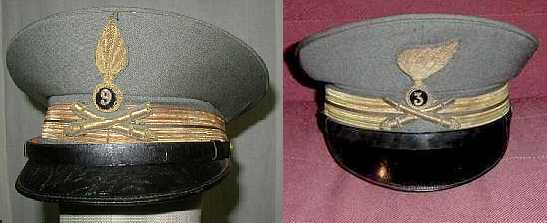
Two examples of Peaked Visor Caps
& different insignia.
Corps Artillery and Army Artillery.
Rank was denoted by stripes around base of hat.
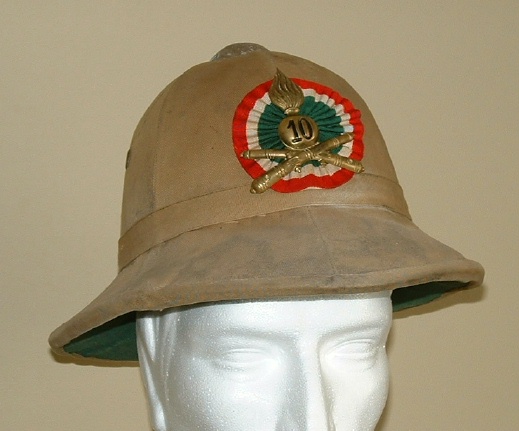
|
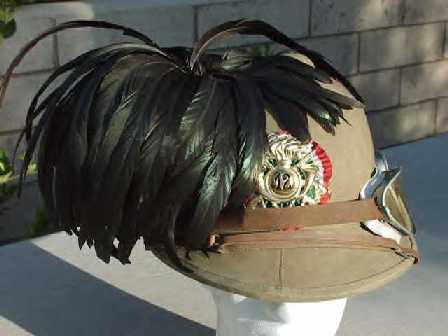 |
|
An Tropical helmet of the 10th Corps
Artillery
The helmet displays a unit
badge on a cloth national cockade. The helmet is made of
cork. This one is missing the leather chin strap.
(From
my personal collection. )
|
A Tropical pith helmet worn by 12th Bersaglieri.
The tropical helmet was
common
for Italian and German troops in North Africa. Note cock feathers and sand
goggles.
The Bersaglieri
wore the cock feathers on their steel helmet.
|
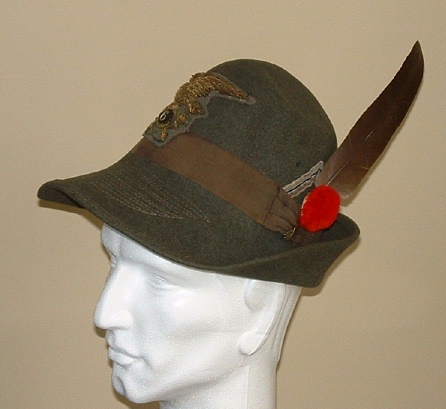
|
An Officer's hat worn by
6th Alpini
Regiment
The Alpini or
Mountain Troops
wore only 1 crow's feather in their hat.
The red pom-pom usually denotes the 2nd Battalion. However,
the 6th Alpini Regiment
did not use red. Instead this was adopted by one company
established
before the unit went to Russia; the 216a Compagnia Armi di
Accompagnamento (216th Heavy Weapons Company.
The 6th Alpini Regiment
fought in Russia with the 2nd Alpini Division TRIDENTINA. This
regiment lead a column of German troops in a breakout of their
encirclement around Stalingrad.
(From
my personal collection, thanks to Balbi Fabio. )
|
Fascists Organization after
September 1943
When the Italians
outsted
Mussolini in July 1943 and surrendered to the Allies in September 1943,
the Germans
began taking control of Italy and its army. Germans disarmed the
Italians, executed some, and transported 615,000 Italians to German
labor
camps. The Fascists element that was loyal to Mussolini remained
allied to the Germans and the new puppet Italian government headed by
the rescued Mussolini.
Italian
Social Republic - RSI
The armed forces of the Italian Social
Republic were raised on 28 October 1943, exactly 19 years from the
month
& year that Mussolini came to power. Most of those who joined
did so to avoid the German labor camps. The RSI
consisted of the ENR and GNR.
National
Republican Army or Esercito Nazionale Repubblicano (ENR),
(part
of RSI).
Made up of 4 divisions and smaller
autonomous units that were organized from the Italians that had been
interned
by the Germans when Italy surrendered. The RSI included the ‘Monterosa’
Alpine, ‘Italia’ Bersaglieri, ‘San Marco’ Marine and ‘Littorio’
Infantry
Divisions. They wore a wreathed sword badge on the lapel of their
tunic.
Republican
National Guard or Guardia Nazionale Republicana (GNR), (part
of RSI).
GNR
was formed as a new Fascist militia(part of RSI) to replace the Black
Shirt
MSVN, from members who remained loyal to Mussolini. They were the
primary anti-partisan security force.
Black
Brigades. Later, a new organization had to be
formed
to support the GNR, called the "Black Brigades" or Brigate Nerre. Their
uniform varied greatly but usually consisted of a black field cap or beretto
da campagna modelled on the German 1943 field cap. A short black
wool
jacket, similar to the British battle dress blouse, was in widespread
use.
One common feature was a unit name badge worn over the left breast
pocket,
generally rectangular, red over black with 'Brigata Nere' in silver.
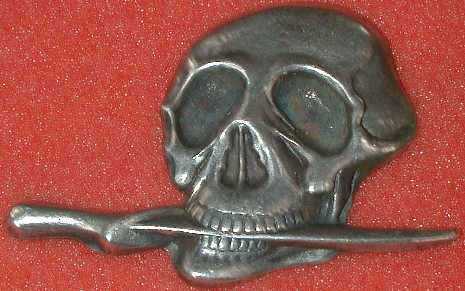
The distinctive
cap badge
of the Black
Brigades was
worn on the uniform and on soft caps. A similar emblem was
stenciled
on a black helmet. (post-1943)
(Red
background for
photo only.)
|
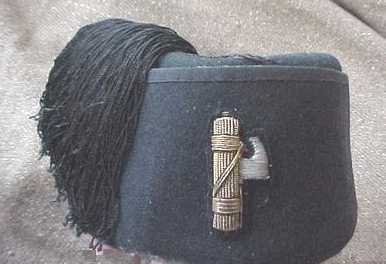
A Fascists Fez with
the fasces
emblem
of the Black
Shirts (pre-1943).
|
X-MAS
(pronounced "Decima Mas") was an autonomous unit of the RSI
forces raised by the commander of a pre-Armistice Italian Navy special
attack unit, the 10th Anti-submarine Motorboat Flotilla (10 Flottiglia
Motoscafo Anti-Sommergibile).
Italian
Waffen-SS
Called by different names as it grew
from a brigade to a full division, it was officially named the 29
Waffen-Grenadier der SS (Italienische Nr: 1). The 29th
SS fought at Anzio front in May 1944, but operated mostly
as a police and anti-partisan unit.
The former Bersaglieri unit, named
Fortunato, returned from the Russian front and was organized into the
"1st
Brigata D'Assalto della legione SS Italiana". One fierce
unit,
named "Debica", fought at Nettuno(Anzio), May 1944, and was the
first
to fight after the armistice. It surrendered on April 29, 1945,
outside
Gorgonzola when surrounded by overwhelming American armor.
On June 15, 1944, the division was
reorganized in Fireze with fresh German and Italian troops and the
Reichsfuhrer-SS
communicated the following order:
"For valor demonstrated and with a sense of duty, the Italian legion of
the
29th Waffen-SS shall hereafter adopt the black collar and grade
insignia
of
the German SS and be eligible for all duties and rights of the German
SS."
The motto of the Italian SS Division
was "Per l'Onore e per la Vita" which was similar to German SS unit's
motto
"Meine Ehre heisst Treue".
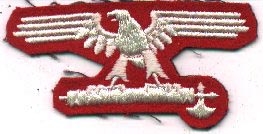 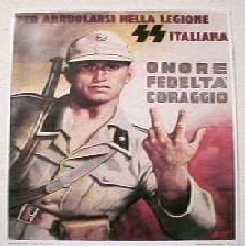
An Italian SS patch and a recruitment
poster.
The SS patch is similar to
the
Waffen-SS emblem, except the eagle holds a fasces instead of
the
German swastika. The SS eagle patch was worn of the left sleeve
instead
of the right breast pocket as with other German branches of
service.
The patch and collar tab insignia were originally on a red
background
but later changed to a black backgroud. |
Other RSI
units:
A large number of small autonomous units were raised that only existed
briefly.
Ispettorato
Speciale Polizia Antipartigiana (ISPA) - Anti-partisan police unit
White Flame
or Fiamme Bianche – Boys of Fascists Youth movement.
Sardegna
Volunteers
Battalion – A 500-man unit that operated near Yugoslavian border.
Alpine Rifles
or Moschettieri delle Alpi – Ex-Alpini soldiers in the Aosta region.
Appenine
Hunters
or Cacciatori degli Appennini – A major anti-partisan unit with 3
regiments,
reportedly a strength of 10,000.
Women
Volunteer
Corps (SAF)
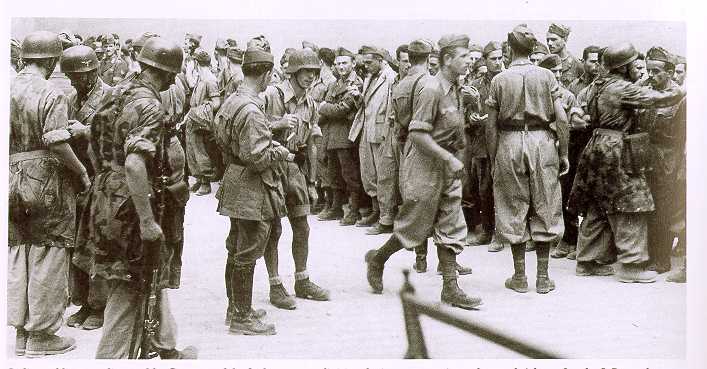
The Germans began Operation ACHSE
to disarm the Italian Army after the September 8, 1943 Armistice.
The Italians in this photo
are being disarmed by the German 2nd Parachute Division.
Of interest are the various types
of smocks, shirts, shorts and pants worn by the paratroopers.
Note the Luftwaffe eagle on the
German
paratrooper helmet(2nd from left).
Photo Source: "Mussolini's Soldiers", a good refernce book on
Italian
uniforms.
Military
Organization of the Co-Belligerent Forces
After September 1943, the Royal
Army that could surrender to the Allies
did
so and were re-equipped as support troops. Those that were in areas
controlled
by the Germans met the fate mentioned above. The following are the
combat
units formed from the remnant of the Royal Army and
served the Allies. Many Italians provided direct support to the
Allies on an unofficial basis as translators, guides and logistical
support.
1st Motorized
Group or 1st Raggruppamento Motorizzato was the first
Italian
unit to fight on the side of the Allies at Monte Lungo. On their
Italian uniforms they wore a distinctive small red shield with a white
cross, the symbol for the house of Savoy.
Italian
Liberation
Corps or Corpo Italiano di Liberazione (CLI).
The Badoglio government formed a force of 22,000 soldiers to fight with
the Allies. The CLI were equiped with Italian uniforms and
material.
The CLI were organized into two divisions: 'Nembo' & 'Utili' from
the
former Nembo parachute division and the 1st Raggruppamento Motorizzato(above).
These troops saw action at Gustav Line & Monte Cassino. After
4 months, it grew large enough and was formed into 6 Combat Groups(see
next item).
Royal
Army or "Army of the South" or Co-Belligerent Forces
The Combat Groups were eventually
armed and equipped with Allied supplies, mostly British. A Royal
Army star was worn on the collar. The individual combat groups
were
identified by a rectangular, tricolor arm patch on their left sleeve
with
a central figure described below.
‘Cremona’ – ear of
wheat
‘Mantova’ – an eagle
‘Legnano’ – a
knight
‘Piceno’ – a Roman arch
‘Friuli’ – a city
gate
‘Folgore’ – a lightning bolt
Pack Transport
Units. Italian volunteers were used to lead mule trains
through
mountain trails to supply the Allies with food, ammunition and
supplies.
This was a very dangerous job as the mountain trails were few but often
mined and their exact
location were plotted by the German artillery. They were equipped
with a special British battledress dyed dark green and wore an arm
badge
of a red circle with green letters "TN". Since many had been
ex-Alpini
troops, they often wore Alpine hats.
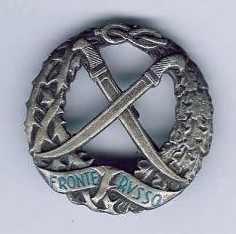
Russian Front Badge
"FRONTE
RUSSO"
Issued to troops who fought at
the Russian Front, this badge was
proudly worn by both RSI
and
Royal
Army troops on the breast pocket.
"If you think its cold here, you should be in Russia"
an Italian saying.
Partisan
Organizations
A Short
History
of Italian Resistance
The anti-fascists movement began
soon after the March on Rome in 28 Oct 1922, which established
Mussolini
as the primary power in the Italian Republic. Mussolini began to
control the county and put an end to riots and unrest. Some
people
thought the Fascists were becoming too powerful. Sandro Pertini
was
one of the first to rise up and mobilize public opinion against the
Fascists.
The Black Shirts beat him and eventually sentenced him to 15 years of
solitary
confinement.
Pope Pius XI saw
in Mussolini an ally to combat bolshevism. The church in Italy,
like
the church in Germany in 1933, signed a concordance. The Church
gave
up political power in the state in exchange for recognition as the
state
religion and the autonomy of the Vatican. This also ended the
Catholic
youth clubs.
In 1935 Mussolini
invaded Ethiopia, breaking his promise of “peace and order”. Then
Mussolini began to ally with Hitler and made a pact in 1939 that
included
a promise of peace. Many influential Italians preferred
friendship
with the British and French. By 1942, the country had suffered
from
fighting in North Africa, Greece, and Russia. Condition at the
home
front had worsened and there were riots due to food shortage.
Most
people thought fascism was good in the beginning because it brought
order
and ended the riots. The joke was that everyone was a Fascist but
no one was. Many university intellectuals paid lip service but
continued
to teach democratic principles. Underground newspapers
sprung
up around the country but the country was still ruled under Mussolini's
strong arm.
The day Mussolini
was removed from office, 25 July 1943, the Christian Democrat party was
formed. It stated it was not a Catholic party—but it
received
support of conservative Catholics and clergy. As the Fascists
re-organized
under the protection of the Germany Army, more resistance groups formed
seperately in different regions of the country. The resistance
groups
grew and were organized into committees. The partisan were
supplied
with weapons and supplies by the Allies, usually by night parachute
drops.
As the Allies pushed further north, the numbers of partisans
grew.
By the end of the war, there were 224,000 militant partisans. Of
these 63,000 were killed and more than 33,000 wounded, in addition to
15,000
to 20,000 civilians who were murdered.
Committe of
National Liberation - Comitato di
Liberazione
Nazionale(CNL)
or Corpo Voluntari della Libertà (CVL).
A committee to oversee the various
partisan groups, including following political parties:
Catholic
Party - "Peoples" or "Catholic Brigades"
Socialist
Party – Matteotti Brigades
Republican
– Mazzini Brigades
Anarchist
– Red Flag Units
Actionist
Party – Justice and Freedom Brigades
There were other organizations that
were formed on a local basis. These included the Osoppo Brigades,
formed by two priests, which grew to the strength of 10 battalions by
April
1944. The Green Flames was a unit from Lombardy. Other
units
were Ossola Valley and Aosta Valley groups.
National
Liberation
Committee for Northern Italy (CLNAI). A group of partisans
behind German lines in Northern Italy that was established as a rival
to the CLN.
Gruppi de
Azione
Patriotica (GAP) (Groups for Patriotic
Action).
One of the first well-organized partisan groups.
Staffetta
- "Messenger" - A group of
patriotic
workers, mainly women, who were performed the important role of
communications
between different partisan groups and leaders. These could
be "pregnant" women transporting leaflets or ID cards or "Red Cross
nurses"
smuggling medical supplies.
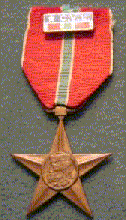
|
Garibaldi
Star
A medal
awarded
to Resistance fighters.
(Resembles
the US Bronze Star Medal
in shape
& color of ribbon.)
|
References:
"The Other Italy: The Italian Resistance in WW2"
- by Maria de
Blasio
Wilhelm, W.W. Norton & Co., 1988.
"Mussolini's
Soldiers" - by Rex Trye, Motor Books Intl, 1987. ISBN
0-7603-0022-4.
"The Allied
Forces in Italy; 1943- 1945" - by Guido Rosignoli. David &
Charles Publishers, 1989. ISBN 0715392123.
"The Italian Army
(1943-1945)" - 3 volumes - Osprey's Men-At-Arms series by Philip
S.
Jowett. Osprey Pub Co., 2001.
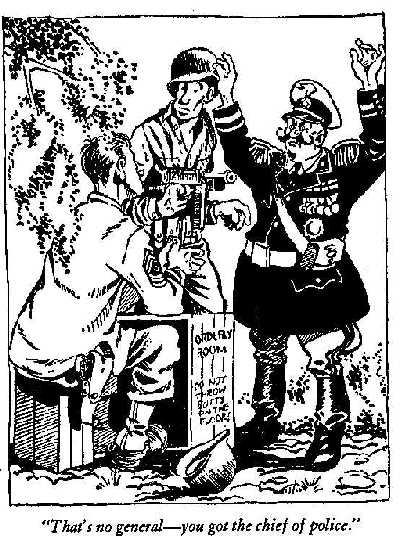
The Italian Uniforms was quite
confusing for the Americans
as Bill Mauldin's cartoon so
aptly
conveys.
|
One Opinion of the Italian Soldier
"Italian
soldiers are neither better nor worse than the soldiers of any other
nation. All men are by nature fond of the
family, of life and peace. To enjoy war is
surely degenerate; it appeals more to the single, adventure-seeking man
than to the father of a family. Yet in the
life of a nation the father, as head of the smallest unit, is more
important than the adventurous youth, who in war is the first to be
sacrificed. This fact was even more
significant to the Italian, who lives so much within the family, than
to the German. If the father of a large
and young family is killed in action, the only result is bitterness and
woe.
"Before
the days of Mussolini,
Italy
was not averse to war. How otherwise could
it have successfully borne the heavy and protracted battles of the
Isonzo during the First World War? Piedmont
is the cradle of Italy’s
military prowess. With the exception of Prussia,
no dynasty was ever as militant as the House of Savoy.
It was the campaigns of the Piedmontese battalions that
unified Italy,
thereby fulfilling the dreams of many generations.
Everywhere the memorials bore witness to this fact.
"At Turin and in that neighborhood were a number of
military schools. The Peidmontese nobility, like the Prussian one, put
service in the army on a higher plane than any other service to the
state. The discipline was good. In Piedmont there were also many alpine units, the
best that the Italian Army could produce---proud, quiet, outwardly not
very disciplined troops, but reliable types, brought up the heard way,
accustomed to camping in the eternal snows with only the barest
supplies. They were magnificent soldiers, to whose pride and
modesty I paid tribute whenever I happened to encounter an Alpino. The Navy, too,
was good, though I had few contacts with it."
Quoted from book "Neither Hopr Nor Fear", by General Frido von Senger
und Etterlin, the defender of Cassino and the German commander of the
XIV Panzer Corps.
|
Return to TOP
Return to Units
& Organizations
Return to The
Italian Campaign main menu.
.











